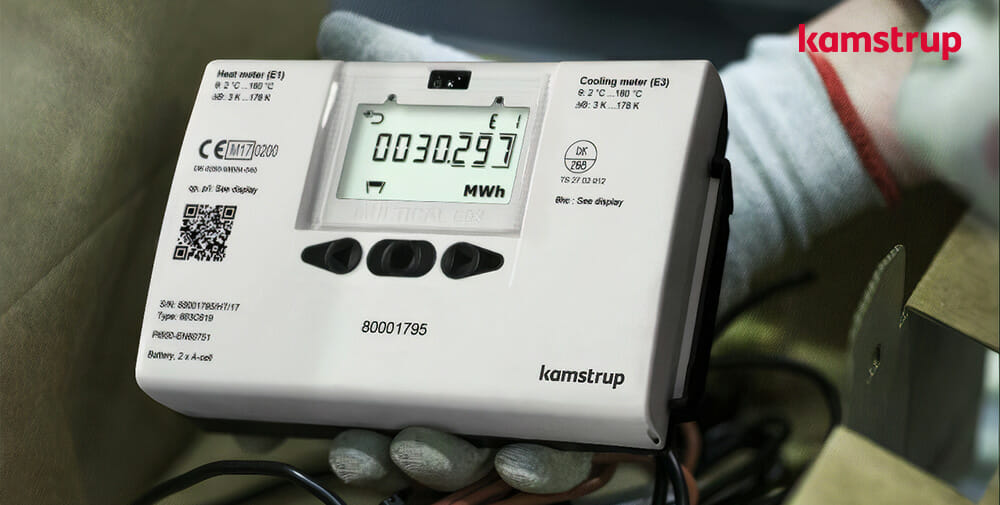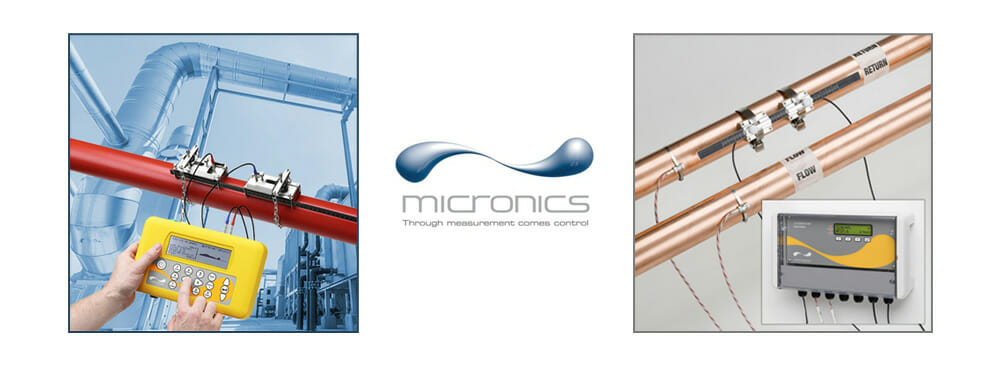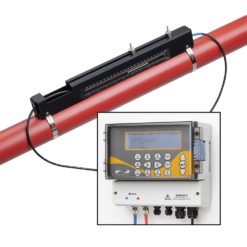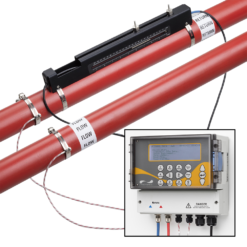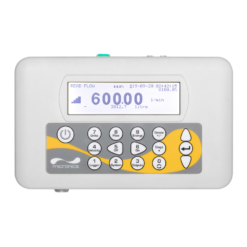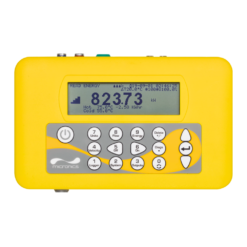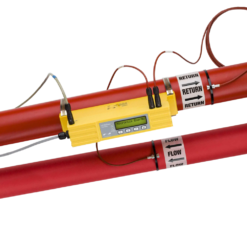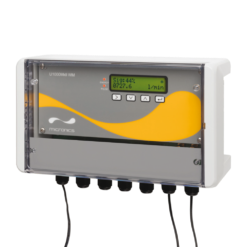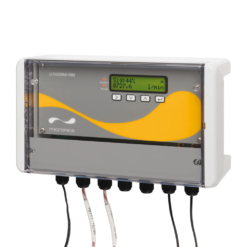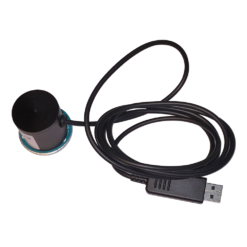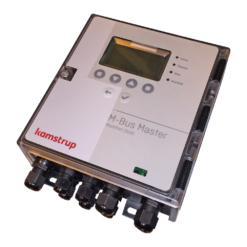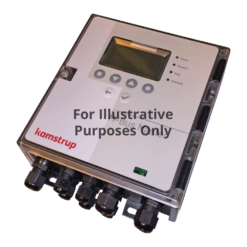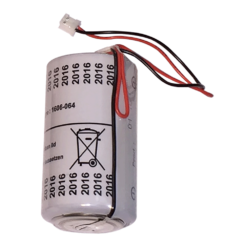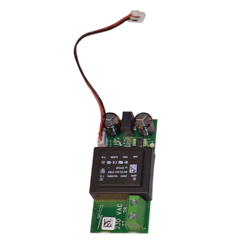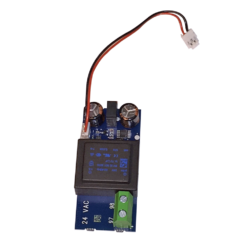Building Management Systems / HVAC
Modern day commercial buildings, hospitals and schools across the UK use buildings controls technology or building management systems in order to increase operational and energy efficiency.
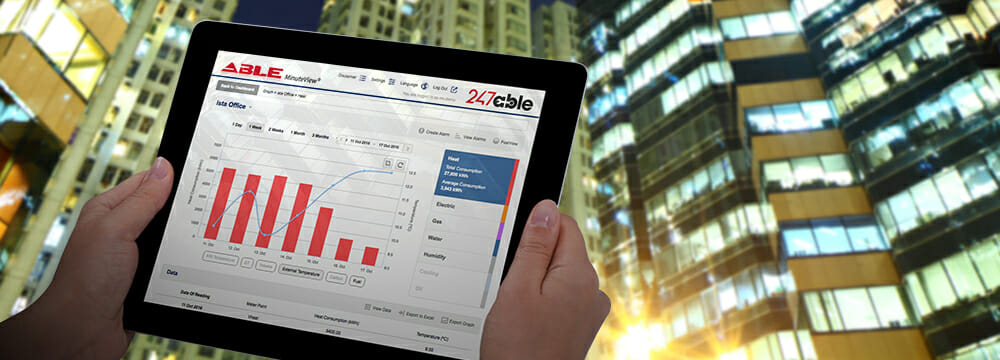
When it comes to Building Management Systems and HVAC, the measurement disciplines and sensor types offered by ABLE have a symbiosis and commonality with the heavy industry process instrument solutions we provide. For example, ABLE’s proficiency in flow measurement, particularly ultrasonic, makes us ideally positioned as a heat metering supplier, and our well recognised expertise in humidity and light measurement promotes an inherent understanding of the environmental management of buildings.
Whether you want to protect the valuable artifacts in a museum or art gallery, or form part of a logic control system for HVAC panels on an oil rig, ABLE can provide the correct solution.
What is a BMS?
A Building Management System (BMS), otherwise known as a Building Automation System (BAS), is a computer-based control system installed in buildings that controls and monitors the building’s mechanical and electrical equipment such as ventilation, lighting, humidity, temperature, power systems, fire systems, security devices, IOT sensors, energy and gas meters. A BMS consists of software and hardware; the software program, usually configured in a hierarchical manner, can be proprietary, using such protocols as C-Bus, Profibus, and so on. The purpose of the BMS is to make a buildings comfortable, functional, efficient and safe.
Building management systems are most commonly implemented in large projects with extensive mechanical, HVAC, and electrical systems. Systems linked to a BMS typically represent 40% of a building’s energy usage; if lighting is included, this number approaches to 70%. BMS systems are a critical component to managing energy demand.
However, intelligent building management systems are only as good as the quality of the inputs they receive from the variety of sensors, often referred to as peripherals, interfaced with them.
Peripheral Inputs for Comfort, Efficiency and Safety
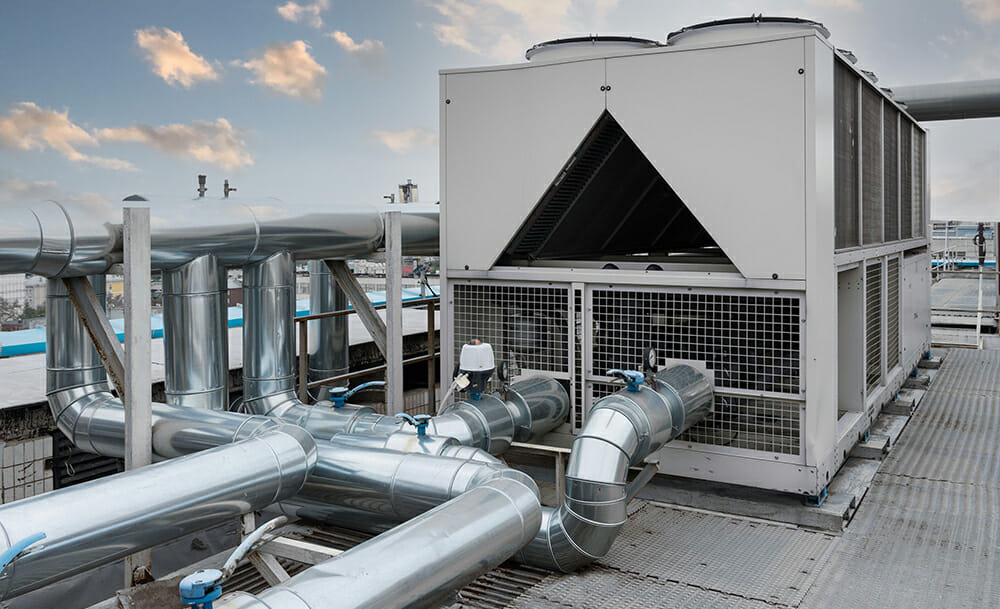
For environmental control and maintenance of the comfort zone, ABLE supply a range of high-quality relative humidity (RH) and temperature sensors. Humans generally feel comfortable at temperatures between 22 °C to 27 °C and a relative humidity 0f 40% to 60%. Of course, if the temperature rises, the relative humidity decreases, so any BMS must be able to detect the change and respond accordingly to rebalance the environment. This may be effected by an injection of water vapour and/or the use of a chiller unit to move heat from one location and transport it to another place to chill.
ABLE provide both wall and duct mounting relative humidity and temperature sensors with either a 4-20mA or 0-10v output to match the requirements of different BMS manufacturers.
The RH sensors are electrical and use the change in capacitance invoked by changes in water vapour concentration are the basis of measurement. Available accuracies are +/- 3% and +/- 2% RH. The temperature sensor can either be a PT100 RTD or a thermistor, depending on the accuracy requirements.
In addition to being incorporated into the complete transmitters supplied by ABLE, the fundamental Sensirion SHT75 Polymer Capacitance Sensors are available separately for OEM circuit and humidity instrument design. The sensors are provided fully calibrated with a digital output. Low power consumption and excellent long term stability make them eminently suitable for HVAC peripheral board design and the pin type package makes for easy circuit integration.
Managing More Demanding Environments
When considering industrial and offshore applications a more robust device is required and often one which is hazardous area certified. ABLE offer the Rotork-Schischek range of rugged, modern, reliable and explosion proof HVAC products. Housing choices are die cast aluminium (with an optional seawater resistant coating) or 316L stainless steel. The Model ExCos-D is certified for use in ATEX Zone 1 and 2 (gas) and 21, 22 (dust) hazardous areas. These products add another layer of sophistication to the blind transmitters referenced above with backlit displays and programmable universal functions. The measuring ranges are scalable within the maximum ranges. The analogue output signal is either 0…10 VDC or (0)4…20 mA and can be selected on site. The integrated display (can be switched off as needed) is for parametrisation and an actual value indication at working mode. The Schischek portfolio also includes a range of explosion proof differential pressure switches and transmitters and thermostat/hygrostats, all designed for use in HVAC systems in pharmaceutical, chemical, industrial and offshore environments.
Additional Layers of Sophistication
As time has progressed, building owners have been driven to reduce their energy usage, climate change and cost being key reasons as to why they want this to happen. So, the BMS has become a tool for not just comfort control but also as a valuable asset to be able to help manage and maintain the energy usage within the building.
The monitoring of light levels is another key aspect of environmental and energy management, for the purposes of safety and cost saving. For example, light sensors may be positioned throughout a large retail store where the aim is to maintain adequate levels of illumination in the shopping aisles. Light sensors with a good approximation to the spectral range of the human eye (400-700nm) measuring lux levels, positioned around the store, provide a control input to the BMS; when ambient natural light levels are high, the BMS can reduce the store lighting output and vice versa. Sensors deployed to this application would typically have a relatively low range of 0-2000 lux, whereas sensors performing the same function in a car park, which will be exposed to direct sunlight, would have at least a 0-20,000 lux range.
Other examples of advanced peripherals are:
- Indoor Air Quality Sensors to monitor for a range of common internal pollutants including Volatile Organic Compounds (VOCs), formaldehyde, viable moulds and bacteria, dust, carbon monoxide and carbon dioxide.
- An Occupancy Sensor is a motion detecting device used to detect the presence of a person to automatically control lights or temperature or ventilation systems. The sensors use infrared, ultrasonic, microwave, or other technology. The term encompasses devices as different as PIR sensors, hotel room keycard locks and smart meters. Occupancy sensors are typically used to save energy, provide automatic control, and comply with building codes.
- People-flow Sensors: Detecting people and the direction of movement, these can be used to monitor real-time people flow in and out of any single-occupant doorway. Bi-directional, they detect people as they walk towards or away from the sensor, so you can determine the number of people in a space. These only detect movement, not faces, and they are not cameras, making them privacy and GDPR compliant.
- Smoke Sensors detect levels of airborne particulates and gases. While they’ve been around for a while, the development of IoT means they’re now able to notify users of problems immediately.
Energy Management
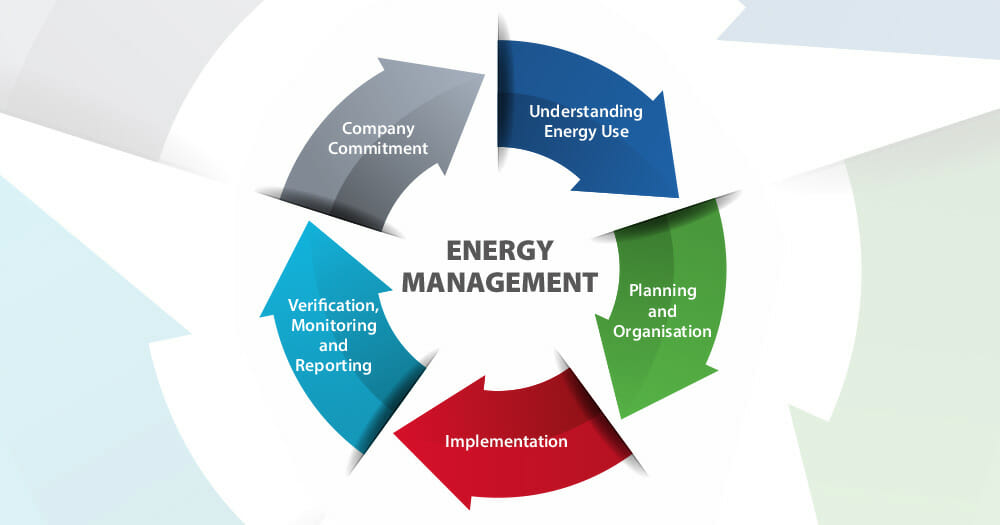
Energy management is the process of tracking and optimising energy consumption to conserve usage in a building. There are few steps for the process of energy management:
- Collecting and analysing continuous data.
- Identify optimisations in equipment schedules, set points and flow rates to improve energy efficiency.
- Calculate return on investment. Units of energy saved can be metered and calculated just like units of energy delivered.
- Execute energy optimisation solutions.
- Repeat step two to continue optimising energy efficiency.
Energy management includes planning and operation of energy production and energy consumption units as well as energy distribution and storage. Objectives are resource conservation, climate protection and cost savings, while the users have permanent access to the energy they need. It is connected closely to environmental management, production management, logistics and other established business functions.
Heat Metering
The centralised production of heat and the distribution of heat as a utility (for example district and communal heating systems) necessitates the measurement of the heat supplied for monitoring and billing purposes. Financial incentives to encourage the generation of heat from renewable sources also depend on the measurement of the heat generated to quantify the amount of renewable heat. Heat metering is essentially another form of utility metering, with the principal difference being that heat energy is more complex to measure than electricity or gas.
Heat meters are devices used to measure heat or thermal energy. In a heating system the thermal energy is directly proportional to the product of the fluid flow rate and the fluid temperature difference. A heat meter consists of a flow measurement device, a pair of temperature sensors to measure the temperature difference, and a calculator to determine the thermal energy on the basis of the inputs from the flow and temperature difference, and a calculator to determine the thermal energy on the basis of the inputs from the flow and temperature difference.
The principal application of heat metering is for the billing of heat supplied to consumers through district or communal heating systems. This is another form of utility metering (similar to gas, electricity, or water). In the UK, heat metering is also used for the measurement of renewable heat, in connection with the Renewable Heat Incentive (RHI) scheme.
Kamstrup
As experts in ultrasonic flow metering, it is apt that ABLE should offer Kamstrup’s leading brand of intelligent meters. Our extensive range includes the Multical 302, 403, 602, 603, 801 and 803 heat, water and cooling meters.
All Kamstrup heat meters we supply are Class II, MID approved and compliant with the RHI (Renewable Heat Incentive). Features can include hour counters, current, maximum / minimum flow through to unique customer numbers, tamper proofing, segment testing and military grade manufacturing.
Multical 603 – A Flexible, Future Proof Heat & Cooling Meter
The MULTICAL® 603 is an all-round calculator, suitable as heat meter, cooling meter or combined heat/cooling meter together with 1 or 2 flow sensors and 2 or 3 temperature sensors. The meter is intended for energy measurement in almost all types of thermal installations where water is used as the energy-conveying medium. MULTICAL® 603 can, in addition to heat and cooling measurement, be used for leakage monitoring, permanent performance monitoring, as power and flow limiter with valve control as well as for energy measurement in both open and closed systems.
Key features:
- Fully programmable data logger with minute loggers
- 2 second integration interval
- 16 years battery lifetime at a reading interval down to 10 seconds
- Option for built-in M-Bus
- 2 communication modules
- 7 or 8 digit display resolution
- User-friendly interface with 3 push buttons
- Option of backlit display
- Mixed fluid compatible
Via the Kamstrup brand ABLE offer further energy management services. We offer a comprehensive range of integrated energy services for the property and housing sector, designed to increase energy efficiency in buildings.
Our range of energy metering services include:
- Supply, installation and commissioning of RHI and Mid Class 2 approved Kamstrup Multical Energy Meters
- Consumption metering and billing of energy, water and ancillary costs
- ‘MinuteView’ web portal for easy and convenient data management
- Energy supply, measurement services, smart metering and billing as a complete package solution
- Analysis of the consumption data for energy and water if required
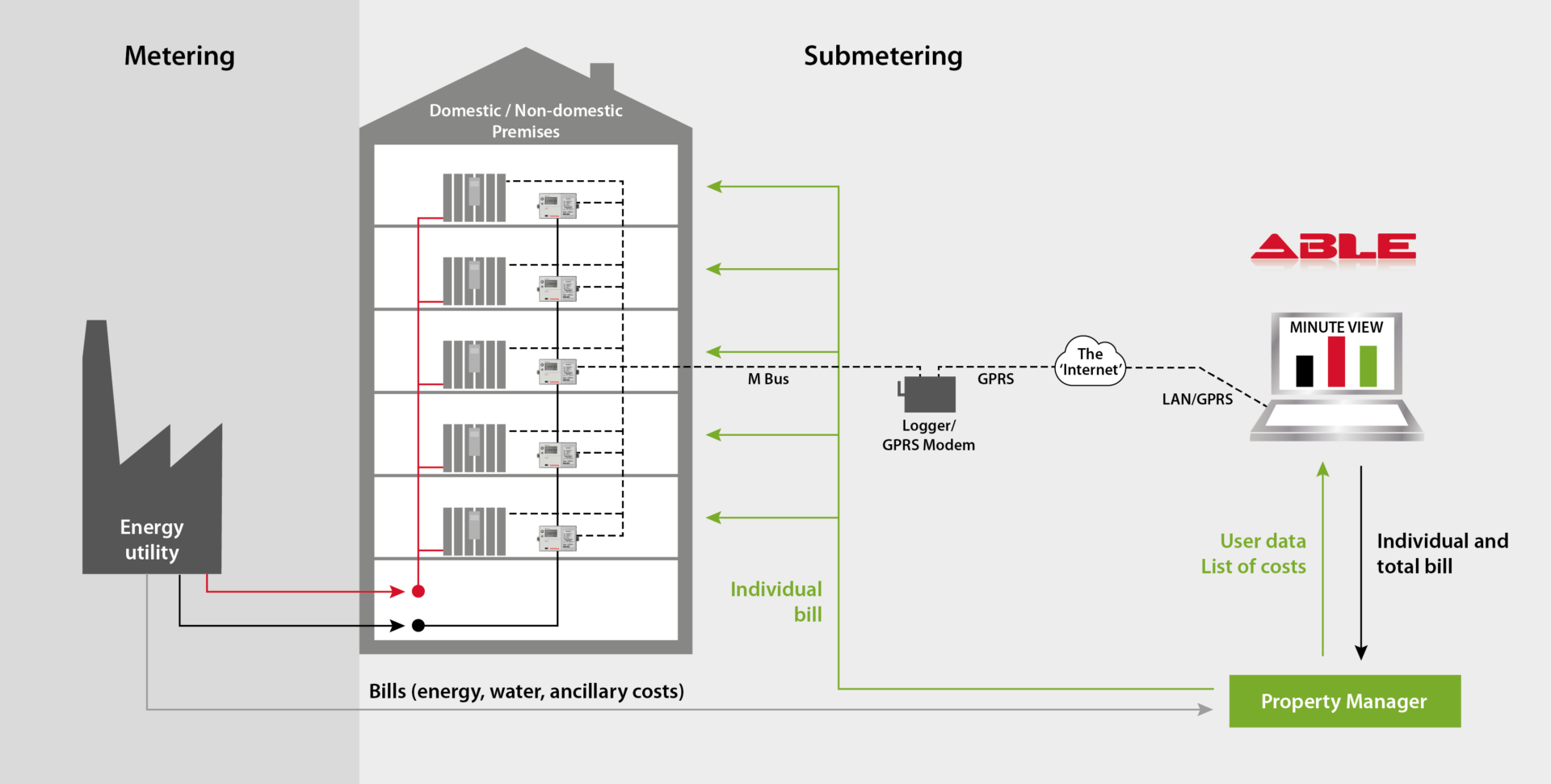
Micronics Non-invasive Ultrasonic Metering Systems
ABLE also provide the Micronics range of heat and energy management meters, which use a technology common to our high-end range of industrial flow meters, namely clamp-on ultrasonics, deploying both “Time of Flight” and “Doppler” methodology.
The Micronics range includes both portable and fixed variants using non-invasive ultrasonic sound transition. These compact designs, comprising pipe mounting transducers and keypad with backlit display or a wall mounted electronics and control unit, are ideal for monitoring and controlling heating, ventilation and air conditioning systems. They are perfect for applications where flow disruption is simply not an option.
We are on hand to answer any questions you may have regarding Building Management / HVAC products, please feel free to call us on +44 (0) 1189 169 420 or contact us for a callback. We also offer ongoing product support.





